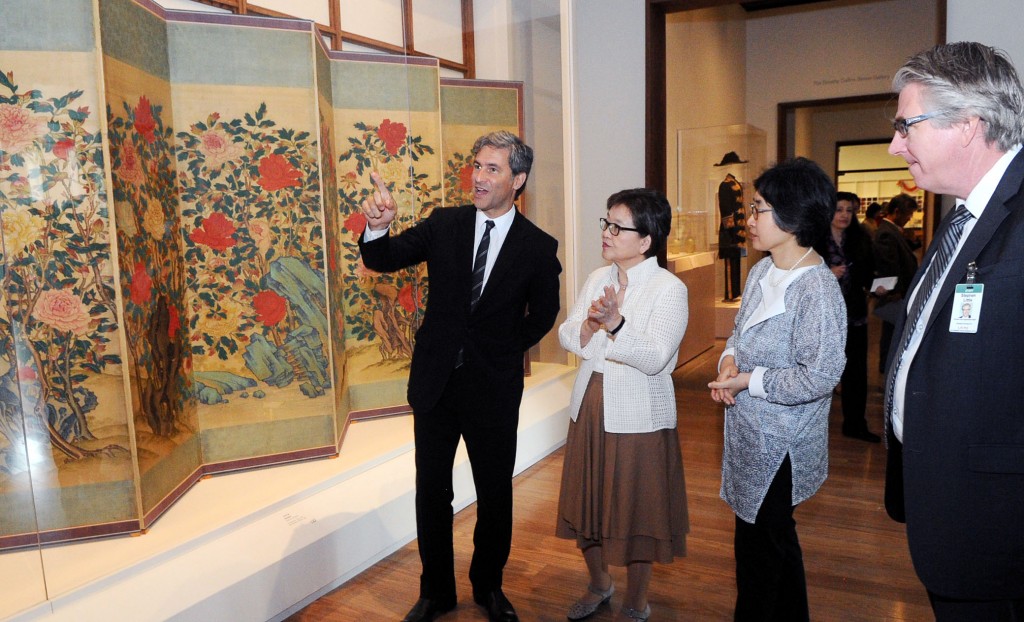- California Assembly OKs highest minimum wage in nation
- S. Korea unveils first graphic cigarette warnings
- US joins with South Korea, Japan in bid to deter North Korea
- LPGA golfer Chun In-gee finally back in action
- S. Korea won’t be top seed in final World Cup qualification round
- US men’s soccer misses 2nd straight Olympics
- US back on track in qualifying with 4-0 win over Guatemala
- High-intensity workout injuries spawn cottage industry
- CDC expands range of Zika mosquitoes into parts of Northeast
- Who knew? ‘The Walking Dead’ is helping families connect
LACMA unveils ‘Treasures from Korea,’ open to public Sunday

LACMA Director Michael Govan, left, discusses “Peonies” with National Museum of Korea Director Kim Young-na, NMK curator Lee Soo-mi and Stephen Little, head of the Chinese & Korean Art Department at LACMA, at the press preview on June 25. (Park Sang-hyuk / The Korea Times)
By Tae Hong
“Treasures from Korea: Arts and Culture of the Joseon Dynasty” at the Los Angeles County Museum of Art is scheduled to open to the public Sunday.
The show spans 518 years of the dynasty — the longest Confucian dynasty in history — from 1392 to 1910 and features more than 150 pieces on display, including painted screens, ceramics, scrolls, books, costumes and ritual wares.
“It’s the broadest and most comprehensive show of the Joseon dynasty in the continental United States,” said Virginia Moon, assistant curator of Korean art at LACMA, at the press preview Wednesday.
Moon said she hopes “Treasures from Korea” will introduce Korean history to both Koreans and non-Koreans in L.A.
“We have the largest Korean population outside of Korea here in Los Angeles,” said LACMA Director Michael Govan. “We [at LACMA] consider ourselves a partly Korean museum.”
The museum has shown numerous Korean exhibitions in the past and has its own Korean art collection of about 200 pieces that began in 1966.
Five themes — the court, society, rituals, Buddhism and Joseon in modern times — explore the art, history and culture of the dynasty.
Kim Youngna, director of the National Museum of Korea, visited L.A. to introduce the display. Many of the pieces are Korean national treasures and artwork on loan from the institution.
“In selecting the works and organizing the exhibition, our goal was to enhance the audience’s understanding and appreciation of the history, religion, philosophy and culture of Joseon Korea,” Kim said.
Highlights of the collection include “Sun, Moon, and Five Peaks,” an iconic six-fold screen from the National Palace Museum of Korea, and the “Moon Jar,” an 18th-century porcelain vase.
Govan said he sees the simple, modern jar as an example of how traditional Joseon art could appeal to the modern eye.
“When I drive to work, I see as many signs in Korean as in English. And I always look at the signs and see how beautiful and simple those letters are,” Govan said.
The Korean alphabet — Hangul — was invented during the dynasty, in 1443.
“It was invented to allow regular people to communicate without needing to know all of the thousands of characters of Chinese. It was a democratic idea, that everyone could communicate in writing,” he said. “But there’s also a great efficiency [to the language]. It’s efficient, it’s modern, beautiful. I think that tradition of modernity is beautifully captured in the art of the Joseon dynasty.”
LACMA organized the exhibition in conjunction with the National Museum of Korea, the Philadelphia Museum of Art and the Museum of Fine Arts, Houston.
“Treasures from Korea,” sponsored by The Korea Times, will run from June 29 to Sept. 28 and is located on the second level of the Hammer Building.













![배우 김민희와 홍상수 감독[스타뉴스]](http://www.koreatimesus.com/wp-content/uploads/2025/04/20250408101705671-120x134.jpg)

